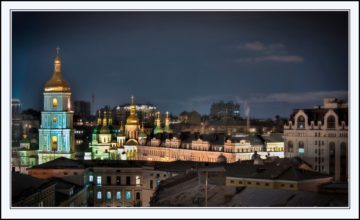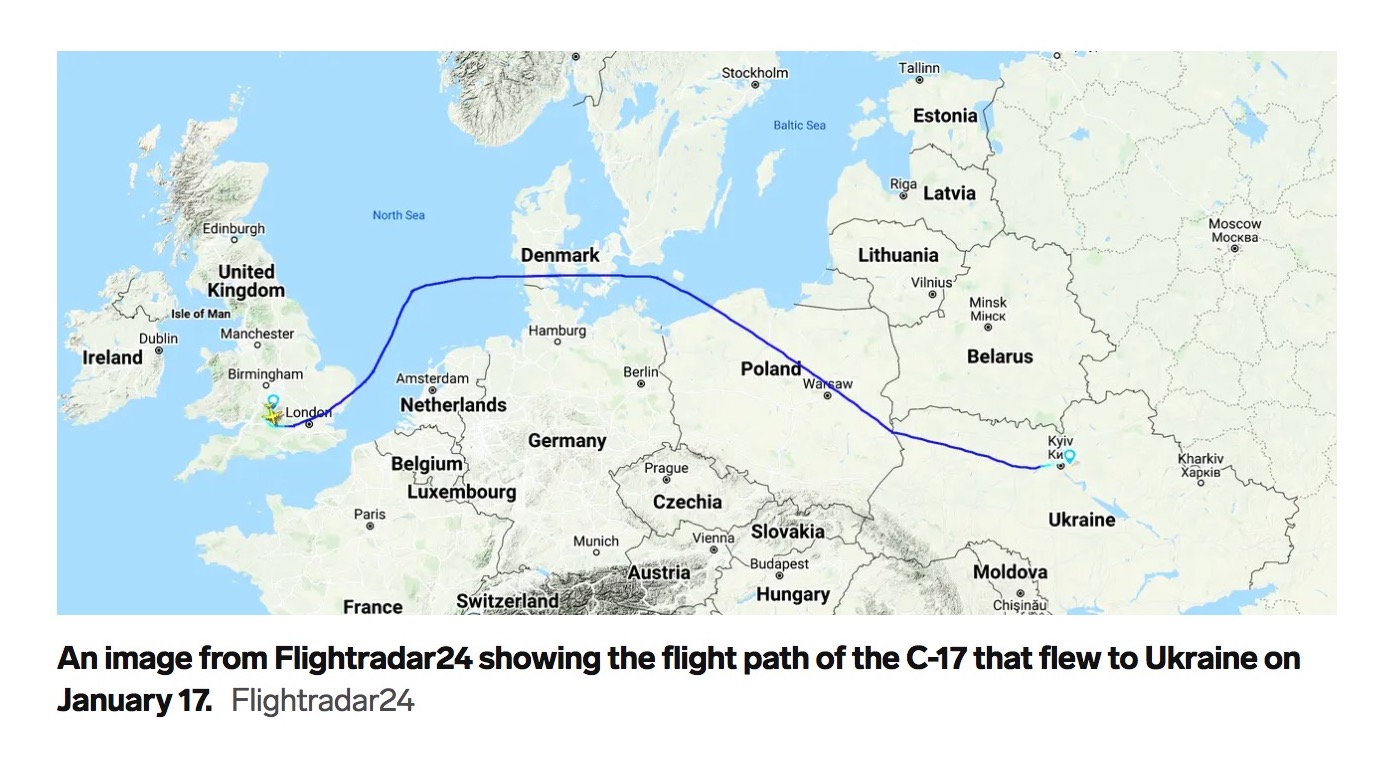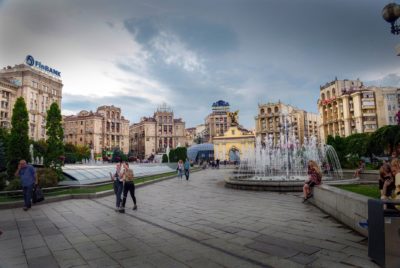by Bill Murray

Ukraine is surrounded by 100,000-plus miserable, freezing, foot-stamping Russian soldiers who are Chekov’s gun on the table in Act One of our new post-Cold War epic. We’ve moved from “surely he wouldn’t?” to “he’s really going to, isn’t he?” It’s the moment when Wile E. Coyote has run off the cliff but not yet begun to fall.
Two years ago Covid crowded out every thing but the most immediate, every body but family. Shocked by the viral invader’s audacity, we scrambled around in a new, unfamiliar world. Everything was frightening. We had precious little time to reflect.
Now comes the malign intent of a real-life invader. Unlike Covid, Ukraine isn’t exactly appearing out of nowhere. Russia has been moving toward military aggression for months. The US president has had time to commit high profile gaffes about any U.S. response. Russian landing craft have moved clear around Europe from the Baltic Sea to threaten Ukraine in the Black Sea. We’ve had ample opportunity to reflect.
So far the west has performed a pretty nifty feat – defying physics. Specifically Newton’s third law, the one about for every action, there is an equal and opposite reaction. Only now, at last, comes a grudging rumble from the big American reaction machine.
If a Quisling-in-waiting sleeps in Russkiy Mir tonight, if Russia installs a Minsk-style puppet in Kyiv, if Russian military hardware further enters and remains in Ukraine, it will be the design of a violent nationalist leader. Threatening sanctions is the response of a technocrat, but at least it’s a response.
Everybody is playing the Vladimir Putin ‘will he or won’t he’ parlor game and opinion is genuinely divided. Those who think this is all elaborate Russian respect-seeking may be right, but I’m skeptical, and here’s why. Watching battle gear arriving from as far away as Khabarovsk (on the Amur River border with China), Ulan Ude (east of Lake Baikal) and Primorski Krai (which is eight time zones from Kyiv and borders North Korea), and then a perfectly timed and well scripted further deployment across Belarus for ‘exercises’ involving 200 trains moving hardware day and night, persuades me that going to all this trouble is more than just saber rattling. If all this is just standing shaking a fist and shouting stay off of my lawn, what’s at stake could turn out to be one mighty costly lawn.
Russia has been moving hardware for weeks. Those hoping this is all a great feint say what’s lacking, if they really mean t0 do it, is field hospitals. During a pandemic, even an autocrat may find it hard to pull medical personnel from civilian hospitals for a training exercise, they say. But over the weekend it was widely reported that the military buildup now includes “supplies of blood along with other medical materials that would allow it to treat casualties.” That sounds real.
Blood supplies aren't generally needed for military exercises, are they? Especially in a pandemic? With your own healthcare system under strain? #Ukraine #NATO #Russiahttps://t.co/9XPvLkCVvu
— Bill Murray writer (@BMurrayWriter) January 28, 2022
After weighing Talleyrand’s advice to Napolean that “My Lord, you can do anything you like with bayonets, except sit on them,” the U.S. president, who has plenty of bayonets, having taken his precious time surveying his options, has begun to fulfill the basic Leader of the West job description, maintaining dialogue, mustering allies, bolstering defenses, polishing strategies.
(And oh lordy don’t you know Jens Stoltenberg is the most relieved man in the house. The NATO chief’s number one mission has to be, don’t be the hapless Nordic fellow who lost Europe. And the most relieved woman must be Ursula von der Layen, the face of the thoroughly sidelined E.U., who as German Defense Minister never met a crisis she couldn’t evade.)
Germany’s new coalition has yet to declare quite how much of a Putinversteher it wants to be, but the answer looks like pretty much. Sympathy is due to new Prime Minister Olaf Scholz, whose government is only fifty days old. His SDP party’s greatest hit is ‘Ostpolitik,’ working with Russia, after all.
Signs are not good. Last week von der Layen’s successor, the new German Defense Minister Christine Lambrecht, declared that Germany “will deliver 5,000 helmets to Ukraine, as a very clear signal, we stand by your side.” As full of élan and camaraderie as it may have looked on the minister’s keyboard, Ms. Lambrecht’s tweet hasn’t exactly been taken as a token of undying solidarity. Yet even that was too much for some German politicians:
5000 Schutzhelme an die Ukraine zu liefern, ist ein fatales Zeichen. Deutschland muss eine Vermittlerrolle einnehmen und darf sich nicht parteiisch auf eine Seite stellen. Die Bundesregierung irrt außenpolitisch planlos umher – Schluss mit diesem Säbelrasseln! #Lambrecht
— Amira Mohamed Ali (@Amira_M_Ali) January 26, 2022
Translated, that’s roughly “Delivering 5,000 safety helmets to Ukraine is a bad sign. Germany must play the role of mediator and must not side with one another in a biased manner. The federal government is wandering around aimlessly in terms of foreign policy – stop this saber-rattling!”
With chalk poised above a blank slate, Scholz’s government has so far squandered the opportunity to set the table for its leadership role in a 2020s Europe. The UK disdainfully shook its metaphorical head and simply flew around Germany to deliver anti-tank weapons to Kyiv rather than be held up by paperwork.

•••••
 Memories of the Soviet Union are aging but they’re not gone yet. Americans of a certain age will remember civil defense markings on the AM radios in their cars. In the event of, say, a Cuban missile crisis, children would duck and cover and drivers would tune to the triangle on their car radio for guidance. When my wife and I spend summers in Finland, we still hear the civil defense test sirens, sounded at noon on the first Monday of every month.
Memories of the Soviet Union are aging but they’re not gone yet. Americans of a certain age will remember civil defense markings on the AM radios in their cars. In the event of, say, a Cuban missile crisis, children would duck and cover and drivers would tune to the triangle on their car radio for guidance. When my wife and I spend summers in Finland, we still hear the civil defense test sirens, sounded at noon on the first Monday of every month.
Civil preparedness is mostly a memory for many of us. But consider lived experience in the new NATO Baltic states. Because Estonia, Latvia and Lithuana were Soviet republics into the 1990s, much of the population speaks Russian and watches Russian TV.
Latvian journalist Kristaps Andrejsons says while “clowns such as Vladimir Zhirinovsky—the leader of the Liberal Democratic Party and a well-known figure in Russia’s ‘controlled opposition’ who has called for the immediate bombing of Kyiv—might be ignored in the Western media, in the Baltics, he and people like him are watched closely.” In the same way that even Donald Trump finds supporters, Russia finds support in the Baltics, because if you live in the Baltics, the threat of war is already in your house.

Consider lived experience in Ukraine right now. American former soldier and Kyiv resident Nolan Peterson writes:
“If an attack is imminent, Kyiv’s air raid sirens will alert residents to tune in to emergency service announcements. Cars equipped with loudspeakers will also patrol the streets to announce important information.
“The Kyiv City Council has posted an interactive online map, which shows the locations of the roughly 5,000 official locations where residents can shelter from a military attack.
“(For example) From ground level, a nondescript metal door opens into a staircase that descends multiple stories underground. The shelter has a special air ventilation room (originally intended to protect against radioactive fallout) and is connected to the city’s water main…. Daily deliveries of food and medical supplies would sustain occupants in the event of a drawn-out Russian bombardment or siege.
“Known as dual-use facilities, the remaining 4,500 shelters include basements, underground parking lots and passageways, as well as Kyiv’s 47 metro stations.
“Should Russian forces target Kyiv … city officials will order a mass evacuation. To that end, a citywide evacuation commission has already been established, as well as regional evacuation commissions in each of Kyiv’s administrative districts.
“Each citizen should prepare an “emergency suitcase” ahead of time…. This should be a backpack with a capacity of at least 25 liters, a little more than 6.5 gallons, containing ‘clothing, hygiene items, medicines, tools, personal protective equipment, and food.’ The service also recommends carrying important documents and cash in the backpack.”
•••••

Russia is forcing a conversation the US doesn’t want to have, at least not right now and not on Russia’s terms. If Russia strikes further into Ukraine, one way or another, as with Covid, the world will change. The first day of renewed conflict will be a fateful, life-changing day for entire nations. Its effects will last the rest of many peoples’ lives. When we look back here from two years on, today may look less complicated, even quaint. I invite you to pause and enjoy the good old days.
Should conflict come, Poland, Slovakia, Hungary and Romania could, like Norway, Finland, Estonia, Latvia and Lithuania, become frontline border states. Russian malign intent will have to be be assumed.
Russian troops already occupy Moldova’s border with Ukraine in a region called Transnistria. Depending on Russian intent, Moldova may face existential questions, but in any case it will acquire a newly threatening neighbor. Any military move in Transnistria will be meant to intimidate not only Moldova but neighboring NATO member Romania as well.
A fundamental geopolitical realignment is hurtling our way that won’t simmer down for years. By spring, tens of thousands of Ukrainian refugees – or more – could be storming the borders of Poland, Slovakia, Hungary and Romania, and how can those countries, how could they hold them back? Across those borders Russia, or it’s newly installed Ukrainian puppet, will try to stare down four new NATO neighbors.
 Current NATO borders in Estonia, Latvia, Lithuania and Norway will be reinforced, and depending on the depth of the next couple of months’ ill will, Finland’s Russian border may be too. With sudden new face-to-face NATO/Russia exposure, all sides will want substantial, fortified borders. Each country will surely want its own sovereign border backed by its own conventional forces. Here come concrete barriers, anti-vehicle trenches, mesh fencing, electronics, guard towers, barbed wire, electronic and other defenses. Suddenly, it’s a good bet that Schengen’s best days are behind it.
Current NATO borders in Estonia, Latvia, Lithuania and Norway will be reinforced, and depending on the depth of the next couple of months’ ill will, Finland’s Russian border may be too. With sudden new face-to-face NATO/Russia exposure, all sides will want substantial, fortified borders. Each country will surely want its own sovereign border backed by its own conventional forces. Here come concrete barriers, anti-vehicle trenches, mesh fencing, electronics, guard towers, barbed wire, electronic and other defenses. Suddenly, it’s a good bet that Schengen’s best days are behind it.
Once we’ve had time enough to consider the longer term, we may find ourselves in a new, raw standoff across conflict-embittered battlefields. Russia v NATO eye-to-eye across borders bristling with weapons and evil intent will be a sight to see. Once again.
Doomsday warnings are cheap for hand-wringing punditry, that’s true. But if some of this stuff does come to pass, world changing ramifications follow. As Sweden’s FM Ann Linde says, “it can still go completely to hell.”
As Covid darkness drew across the world in the early weeks of 2020, I thought, ‘remember this, hold on to this moment, the way things are right now, how good you have it, in case this thing gets out of hand.’
The last two years haven’t been years to love. But now I wonder if we might stop to appreciate even early 2022 the same way. Here we may be, in the twilight moments just before the great mid-twenty-twenties European realignment. Remember these fleeting good old days, while our grasping at the remnants of democracy is not quite yet a wry memory.
•••••
[Radio dial image from Auto Universum, used with permission]

